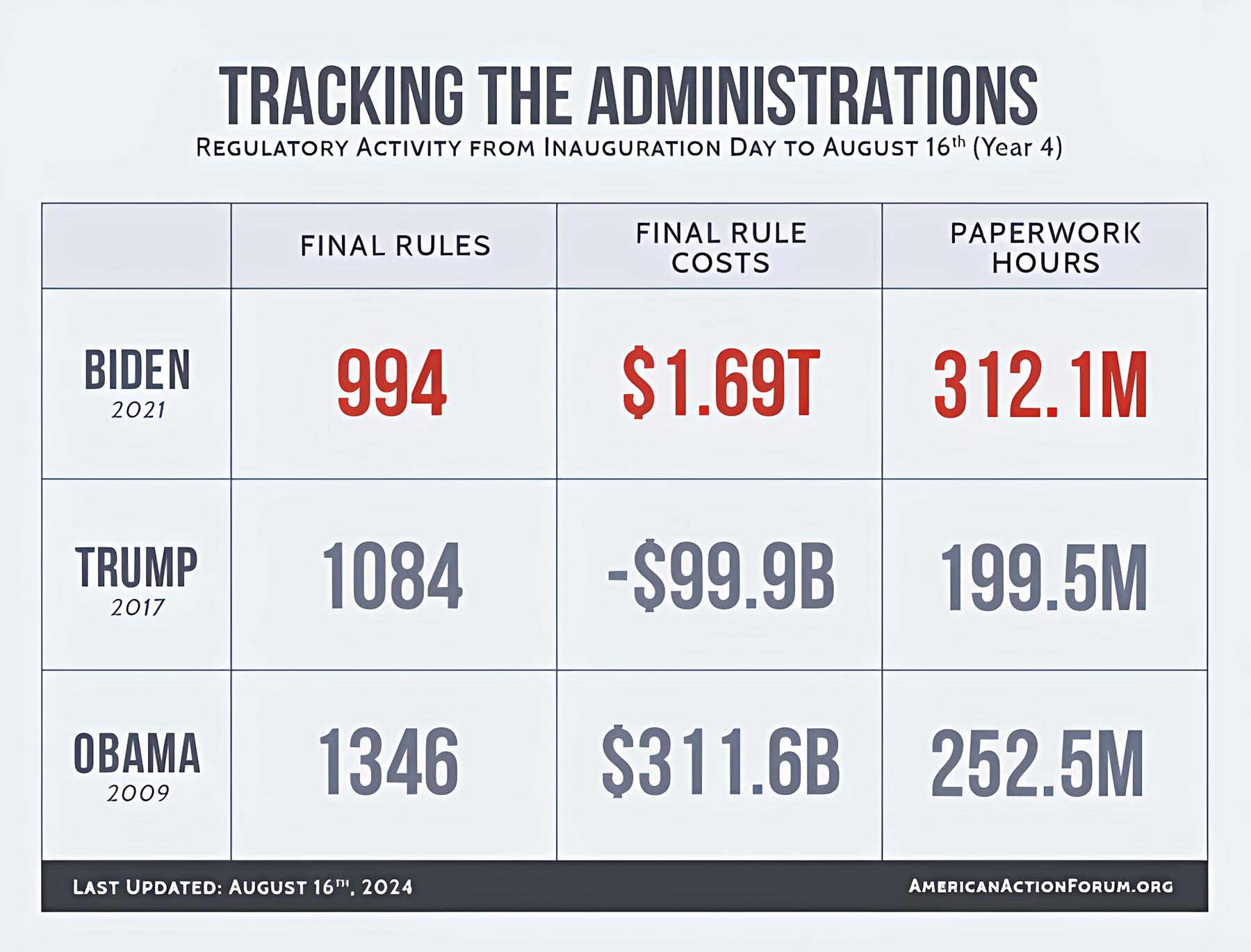By Dan Goldbeck, Director of Regulatory Policy at the American Action Forum
Executive Summary
- As convention season concludes and the 2024 general election season formally begins, attention should focus on the diverging policy visions of former President Donald Trump and Vice President Kamala Harris; this insight considers how each is likely to direct federal agencies to implement their respective agendas.
- A President Harris would likely continue the historically expansive regulatory legacy of the Biden Administration, with perhaps the most notable divergence coming in an even greater willingness to leverage the power of the federal government to artificially determine market prices.
- Voters can expect that a once-again President Trump would implement a regulatory policy vision largely mirroring the record established during his previous term – a vigorous series of up-front initiatives and actions seeking to roll back regulatory burdens on various economic issues – albeit with potentially more aggressive measures on immigration, trade, and various social issues that could impose regulatory costs.

Introduction
As the 2024 general election campaign begins in earnest, Americans’ attention should turn toward the substantive policy differences between the campaigns of Vice President Kamala Harris and former President Donald Trump. Given that so much of the nation’s actual policymaking in recent years – across the past several administrations – has emanated from federal agency rulemakings, it is important to get a sense of where the candidates stand in terms of their respective visions for how to deploy the regulatory state.
Both the Harris and Trump campaigns provide a historically unique opportunity in this regard, with both candidates claiming a kind of quasi-incumbent quality, either in being the immediate predecessor to the Biden Administration, or its clear heir apparent. An examination of the candidates’ records and relevant campaign materials reveals the largely intuitive conclusion that voters can expect a President Harris to continue the Biden legacy of unprecedented regulatory activity, while a once-again President Trump will likely produce a much more restrained result with decidedly deregulatory efforts – but with some clear exceptions on policy priorities such as immigration, trade, and social issues that are inherently regulatory in nature.
Comparing Past Records
Part of the reason one can foresee why these two potential administrations could have such wildly divergent regulatory policy trajectories is because there is a recent record of policy results to draw from. The Trump Administration, in implementing a “regulatory budget” for the first time under Executive Order (EO) 13,771, was able to attain historically constrained levels of regulatory costs. Meanwhile, though not the incumbent president, Vice President Harris as the Democratic nominee has given no indication that she intends to distance herself from the historically high level of regulatory activity put forward under the Biden-Harris Administration.
As the American Action Forum (AAF) noted at the end of former President Trump’s term in January 2021, his administration left office with a net total of $40.4 billion in regulatory costs. AAF also had a deeper analysis of the regulatory budget’s legacy found here. Despite the various deregulatory efforts under his presidency, the only calendar year during which agencies produced net cost savings was 2018. This was primarily due to the simple fact that – outside of a series of rules repealed with the help of the Congressional Review Act – shepherding through deregulatory rulemakings takes time and effort. Additionally, once agencies cleared out the low-hanging fruit during the first part of that administration, there were diminishing opportunities for rulemakings that would have had a measurably deregulatory effect. Nevertheless, one need only look at the chart from AAF’s Trump retrospective to get a sense for how, if nothing else, the regulatory budget framework constrained the growth of regulatory activity…
To continue reading this report, please click here.
The preceding article originally appeared on August 22, 2024 at the American Action Forum’s website and is made available here for educational purposes only. This constitutes a ‘fair use’ of any such copyrighted material as provided for in Title 17 U.S.C. section 106A-117 of the U.S. Copyright Law.



